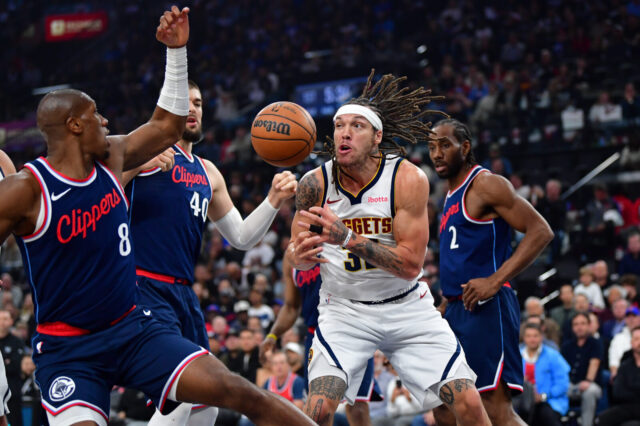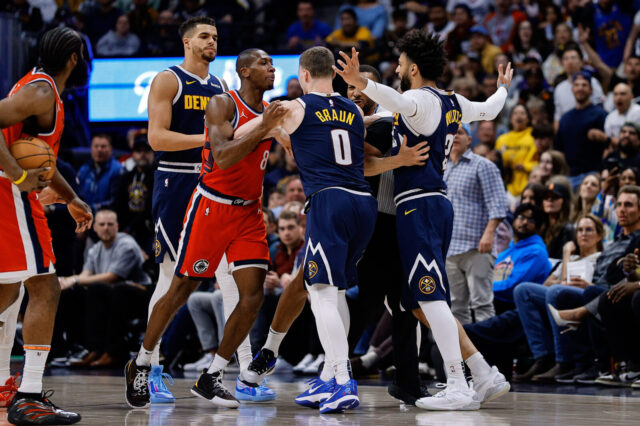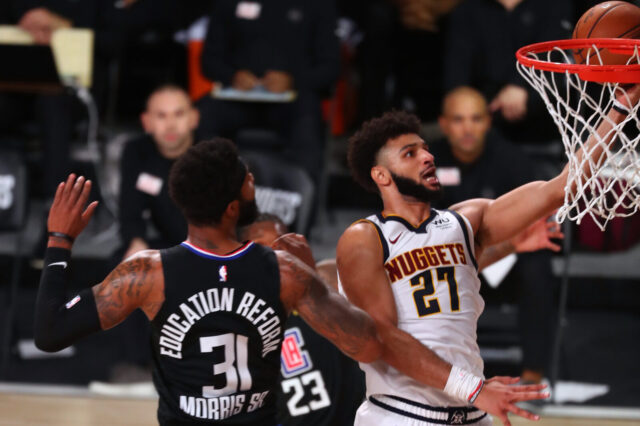If you have something that singularly dominant, and sport tends to accommodate said dominance. The NBA has been obviously guilty of that over the years (overlooking traveling calls in the Jordan years a notable example) but every single league does this. The NFL used to be "three yards and a cloud of dust" for most of its existence until rules were relaxed to encourage more offense, in particular the passing game.
What we have seen in the NBA the last twelve seasons has, inevitably, lead to something that happens in every “era” of the league. Teams using the rules to their logical and some would say illogical extreme to exploit the boundaries of said accommodation of dominance. In the 1990’s, one of the greatest era’s of centers in NBA history, teams isolated in the post ad-nauseum. Games ground to an 80-90 point slog and, after Jordan retired for a second time, fans turned away in droves … particularly after the Lockout in 1998. In the early 2000’s it was isolation from everyone, this was the era of Allan Iverson, Kobe Bryant, Tracy MacGrady and more. You didn’t get anywhere unless you had a great iso guy. This resulted in an over-reliance on mid-range jumpers and stagnant offense.
The “modern” era of the NBA (which is firmly post 2005 lockout) you have seen the gradual advent of “pace and space”. An interesting concept that has actually been around since the stone ages (incorrectly ascribed to Mike D’Antoni’s 7 seconds or less Suns.. when it should be credited to several coaches such as 1980’s Doug Moe and to a certain extent George Karl’s Seattle Supersonics teams) but adapted to the modern era of three point emphasis along with layups/dunks. Due to the advent of the Golden State Warriors and the duo of Stephen Curry and Klay Thompson the modern era has fit like a glove to the concept of guard-dominated offense (in particular point guards) with as much “space” as they need to roam on the offensive end of the court.
The consequence of this emphasis is flopping. In particular on the offensive end of the floor. To put a finer point on it, these 2017 NBA Playoffs have been dominated by a rash of flops for contact on three point shots. Including offensive shooters jumping IN to defenders to draw contact and a foul, and what REALLY rankles people is the flops on screens in order to draw a shooting foul… Which is a new one (and I’ve been watching basketball since I was 9).
****
In a manner of speaking, today's style of play can most likely traced back to a sequence of events in the 2004-05 season.
The now infamous "hand check" rule was implemented before the 2004-05 season. The thinking was to encourage more free flowing offense from point guards and foster greater spacing. The game had become a bit plodding by the late 1990's and early/mid 00's. Games were defense-dominated and scoring was way down across the board. The feeling was if you give the point guard more freedom, offenses will flourish.
A late 2004 game between the Detroit Pistons and Indiana Pacers known as Malice at the Palace on November 19th, 2004 slammed the door shut on physical play in the NBA. It was a brutal moment for the league which had spent a few years cleaning up its image from the rough and tumble late-90’s playoff brawls between the New York Knicks and the Miami Heat (also a preseason rumble between Doug Christie of the Sacramento Kings and Rick Fox of the Los Angeles Lakers)
This has been described as one of the NBA’s darkest hour’s (although the referee betting scandal two years later may be darker) and was maybe the genesis momentum for what we see in today’s modern basketball. Fighting in the NBA had largely been done away with by that point … not counting the Denver Nuggets/New York Knicks slap brawl two years later. The Malice at the Palace was a very strange outlier in a league that had removed much of the fighting in the sport by then. The NBA then implemented a “dress code” which is STILL controversial to those who were around at the time, which emphasized the “behavior and appearance” aspect of NBA Players under the guise of professionalism. This coincided with greater emphasis on flagrant foul rules implemented during the 2001 season.
At the end of 2005, the Detroit Pistons and San Antonio Spurs played one of the least-watched 7 game series in NBA History. A tediously boring affair that despite some close games was really devoid of much drama. The Pistons were a grind it out team, so were the Spurs. It played out poorly to the American public. (Three Finals featuring the San Antonio Spurs … 2003,2005,2007 are among the league’s lowest rated Finals series). There was a feeling, all over, that the product needed to be more entertaining. Mike D’Antoni’s Phoenix Suns were about the revive the run and gun, freewheeling 1980’s style of basketball and the NBA was happy to have the outlier among the other teams in the league.
The NBA felt it had a problem. A problem reaching the casual fan. A problem that could only be solved by freeing up offenses and tamping down the league's perception of outlaw behavior and physical, plodding play. By addressing the dress code in the 2005 CBA the NBA felt that it could progress to an overall better product for the casual fan. Emphasis on casual fan.
However there is one little-remarked rule change from a decade before the Malice at the Palace that has generated FAR greater impact on the current NBA game. Before the 1994-95 season the NBA, without much fanfare, changed the amount of foul shots you get when fouled on a three point attempt from two shots to three. It took nearly two decades to see the real consequence of this rule change … and in combination with the hand check rule and the emphasis on space (changing illegal defense to defensive three seconds in 2001 also contributes to the "space" part of the equation)
Getting fouled on a three when you don't have to worry about being checked on the perimeter has created a problem for the NBA.
****
It doesn’t take a degree in Hyperbolic Topology to understand that getting fouled on a three point shot is near the equal to hitting said three. When the NBA loosened hand check rules it put the burden on the perimeter defender to be less physical, particularly at the point of attack. The consequence of this is the assumption of fouling almost always goes to the defender. Referees essentially have no choice within NBA current rules but to assume that the foul is on the defender because physical defense isn’t allowed on the perimeter. Therefore with the advent of percentage based analysis the increase in flop/fouls on OFFENSE is rampant in the NBA.
What I’m saying is … until and UNLESS the NBA makes a dramatic change to perimeter defense rules this will remain a primary mode of attack for NBA offenses. Period. This is where the “evolution” of the NBA has led and if you look at history this mode of attack to gain points was inevitable within the parameters of the NBA’s own rule changes.
There is only one solution that I can come up with that doesn’t include changing the hand check rule or reducing perimeter movement from point guards. Its a very simple rule change that would likely discourage flopping and pinning the defender’s arm in a screen like James Harden does. All the NBA would need to do is return to the pre-1994 rule of making a foul on a three point shot two free throws instead of three. While it won’t stop flopping, it will reduce the endless stop and start of constant 3 to 4 point plays that players go for.
The flow of an NBA right now is approaching 1990’s level stop/start. Its the same as watching a post player endlessly isolate or watching Kobe Bryant dribble the life out of the ball in the mid range. You have freedom of movement with endless attempts to get fouled in the paint or worse get fouled while chucking up a 30 foot three point shot. The NBA will NEVER be a physical league again but something must be done to give defenses a chance. Maybe be slightly reducing the incentive to get fouled maybe we won’t have as much Harden-esque “jump three feet sideways into the defender in order to get fouled on that 30 foot three point shot”.
One can hope. The NBA in 2005 decided to never again be bully ball and effectively killed off the back to the basket center (once again, more rule changes than evolution) but you CAN make the existing product better. Its time to start by reducing these ugly three/flops?


